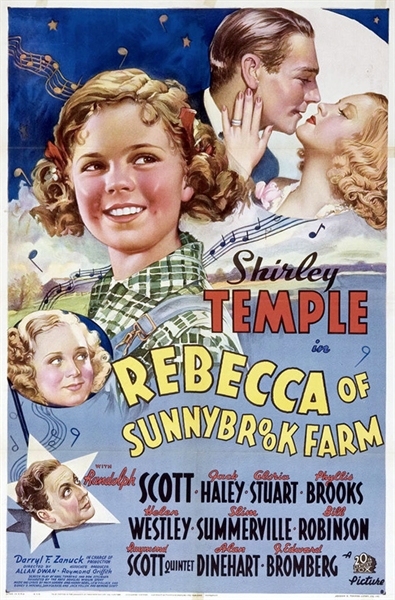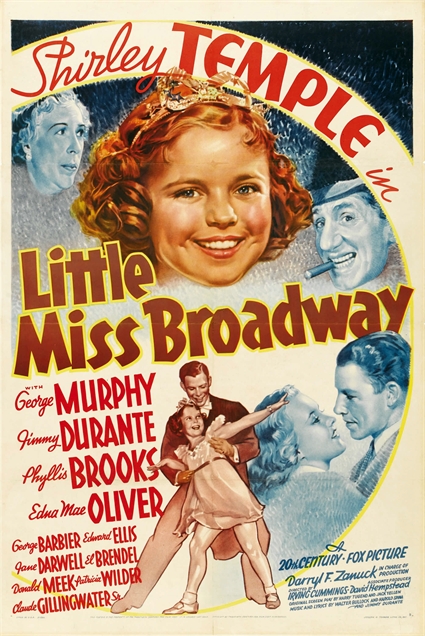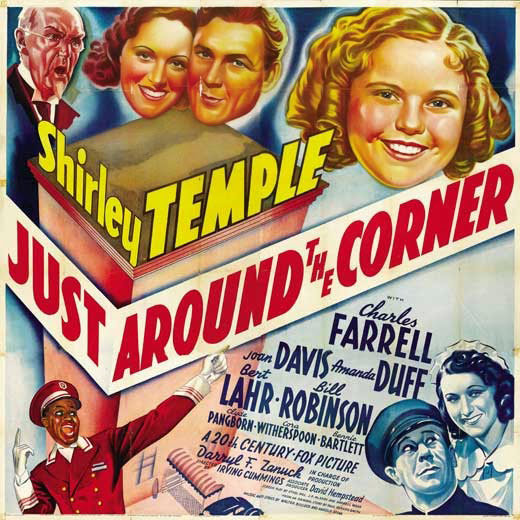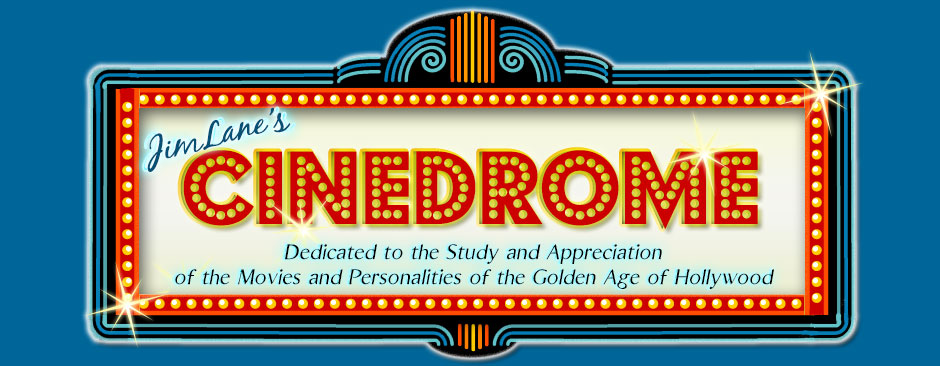Shirley Temple Revisited, Part 12
Despite the success of Wee Willie Winkie and Heidi, 20th Century Fox decided to table, for the time being at least, any literary pretensions in Shirley’s pictures. In Child Star Shirley says otherwise: “Ahead would be Fanchon the Cricket followed by Pollyanna…” — but nothing ever came of those, and she never mentions either title again, not even to explain why they didn’t happen. Both, not coincidentally, had been Mary Pickford vehicles in 1915 and 1920, respectively.
Fanchon, despite what Shirley says, was almost certainly never on the agenda. The 1849 George Sand novel on which it was based (La Petite Fadette) had no particular following in the U.S., and Pickford’s picture of it was long forgotten — presumed lost, in fact (a partial print didn’t surface until 1999). Besides, the character of a semi-feral peasant girl who wins the love of a respectable village boy in rural France was hardly a good fit for Shirley. Perhaps Mother Gertrude mentioned the title for (or to) Shirley, but Darryl Zanuck surely didn’t.
Pollyanna is another case entirely; why that one never happened is a mystery. The idea was a natural, more natural in fact than Heidi. For that matter, Eleanor H. Porter’s 1913 novel was virtually an American carbon copy of Heidi — without goats and mountains, with an aunt instead of a grandfather, and with Heidi and Klara, the crippled friend who learns to walk again, combined into the one character of Pollyanna Whittier. The story could easily have accommodated as many songs for Shirley as Zanuck and his minions cared to throw at it, and could even have been updated to the 1930s without doing serious damage to the original. Fox’s failure to follow this lead has to count as a major missed opportunity, maybe even (depending on the results, of course) a crime against posterity. Could the problem have been that the Porter novel was still under copyright? I suppose we’ll never know.
Shirley wrote about Zanuck “grappling with that chronic demon” of “selecting my next screenplay.” The grappling produced results — Shirley made three pictures in 1938 — but the results were, alas, generally undistinguished. Shirley described one of those pictures as “unfailingly bland”, but she could have been talking about any of the three, and we can deal with each of them in a very few paragraphs.
Rebecca of Sunnybrook Farm
(released March 25, 1938)
 Rebecca of Sunnybrook Farm was another of Shirley’s “no trace” pictures, like Poor Little Rich Girl and (allegedly) The Littlest Rebel. What there was no trace of this time was the 1903 novel by Kate Douglas Wiggin. The story had been filmed faithfully in 1917 with Mary Pickford and again in 1932 with Marian Nixon (produced by Fox Film Corp., so the post-merger studio still had the property lying around). For this incarnation, the studio adopted the same curious practice they had used with Poor Little Rich Girl: take a title widely identified with Mary Pickford, then make a picture with absolutely no connection to what Pickford and Co. did with it.
Rebecca of Sunnybrook Farm was another of Shirley’s “no trace” pictures, like Poor Little Rich Girl and (allegedly) The Littlest Rebel. What there was no trace of this time was the 1903 novel by Kate Douglas Wiggin. The story had been filmed faithfully in 1917 with Mary Pickford and again in 1932 with Marian Nixon (produced by Fox Film Corp., so the post-merger studio still had the property lying around). For this incarnation, the studio adopted the same curious practice they had used with Poor Little Rich Girl: take a title widely identified with Mary Pickford, then make a picture with absolutely no connection to what Pickford and Co. did with it.
As if to ensure that Rebecca would be as familiar as possible, Zanuck and associate producer Raymond Griffith packed the supporting cast with returnees from Shirley’s earlier pictures: Gloria Stuart and Jack Haley from Poor Little Rich Girl; Helen Westley from Dimples, Stowaway and Heidi; Slim Summerville from Captain January; Bill Robinson from The Little Colonel and The Littlest Rebel; J. Edward Bromberg, the deus ex machina judge from Stowaway, serving the same function as a doctor this time; even Alan Dinehart, the sleazeball detective from way back in Baby Take a Bow, was brought back. Of the names on this poster, only Randolph Scott and Phyllis Brooks were new, and both would work with Shirley again before the year was out. The director, once again, was Heidi‘s reliably unimaginative Allan Dwan.
Even the story was a bit of a recycle; as in Poor Little Rich Girl, Shirley becomes a radio star unbeknownst to her ostensible guardian (duties divided this time between her grumpy aunt Helen Westley and shifty stepfather William Demarest) when, while living with her aunt on the farm of the title, she sneaks out for a remote broadcast from the farmhouse of her neighbor, radio producer Randolph Scott.
During that broadcast, Rebecca of Sunnybrook Farm drops all pretense to being anything more than Shirley Temple In Concert. The program’s emcee (Jack Haley) invites Shirley/Rebecca to “sing the songs that made a lot of people happy.” So she sings:
My dear radio audience,
Now I shall do
Some of the songs I’ve had the pleasure of introducing to you…
This, mind you, on what is supposedly her very first broadcast. What follows is a medley of “On the Good Ship Lollipop” from Bright Eyes, “Animal Crackers in My Soup” from Curly Top, “When I’m With You” and “Oh, My Goodness” from Poor Little Rich Girl and “Good Night, My Love” (the lyric changed to “Good Night, My Friends”) from Stowaway. “Ah, but it’s great to reminisce,” Shirley/Rebecca sighs.
Like Captain January, Rebecca of Sunnybrook Farm was one of Shirley’s first pictures to hit TV in the 1950s, so it has a special place in the childhood memories of many Baby Boomers. And giving credit where it’s due, Rebecca is a pleasant enough vehicle for Shirley. But it plows familiar ground while the original furrows are still fairly fresh. Those Baby Boomers (including myself) first saw Rebecca on its own, without the feeling of deja vu that comes from knowing about all the other movies it ransacks for actors, songs and plot elements.
“Flin” in Variety wasn’t fooled. He gave Shirley full credit as “a great little artist”, but added:
The rest is synthetic and disappointing. Why they named it “Rebecca of Sunnybrook Farm” is one of those mysteries. The only resemblance is a load of hay, a litter of pigs and Bill Robinson’s straw hat.
Little Miss Broadway
(released July 22, 1938)
 Little Miss Broadway was the one Shirley called “unfailingly bland”, and that about sums it up. Shirley is once again an orphan, this time moving from her orphanage to live with a friend of her late parents (Edward Ellis) who runs a hotel for entertainers. The curmudgeon this time is the rich old landlady next door (Edna May Oliver, her middle name misspelled as “Mae”), who not only plots to get rid of those unsavory show people by selling their hotel out from under them, but (channeling Sara Haden’s truant officer from Captain January) moves to have Shirley returned to her orphanage. Meanwhile, her playboy nephew (George Murphy) is charmed by Shirley and smitten with Ellis’s daughter (Phyllis Brooks of Rebecca of Sunnybrook Farm) and tries to thwart the old girl. It all ends in the courtroom of judge Claude Gillingwater, with Shirley and her troupers proving that they’ve got a moneymaking show on their hands and can afford to keep the hotel open.
Little Miss Broadway was the one Shirley called “unfailingly bland”, and that about sums it up. Shirley is once again an orphan, this time moving from her orphanage to live with a friend of her late parents (Edward Ellis) who runs a hotel for entertainers. The curmudgeon this time is the rich old landlady next door (Edna May Oliver, her middle name misspelled as “Mae”), who not only plots to get rid of those unsavory show people by selling their hotel out from under them, but (channeling Sara Haden’s truant officer from Captain January) moves to have Shirley returned to her orphanage. Meanwhile, her playboy nephew (George Murphy) is charmed by Shirley and smitten with Ellis’s daughter (Phyllis Brooks of Rebecca of Sunnybrook Farm) and tries to thwart the old girl. It all ends in the courtroom of judge Claude Gillingwater, with Shirley and her troupers proving that they’ve got a moneymaking show on their hands and can afford to keep the hotel open.In the New York Times, Frank S. Nugent was rather sympathetic: “The devastating Mistress Temple is slightly less devastating than usual in ‘Little Miss Broadway,’…Although she performs with her customary gayety [sic] and dimpled charm, there is no mistaking the effort every dimple cost her.” Variety’s “Flin” added: “Shirley is better than her new vehicle, which in turn is better than her last one, ‘Rebecca of Sunnybrook Farm.'” Whether Little Miss Broadway was really better than Shirley’s last vehicle is open to debate. But it was certainly better than her next one.
Just Around the Corner
(released December 2, 1938)
 If Little Miss Broadway was an A-minus picture, Just Around the Corner was no more than a B-plus. If that. Shirley plays Penny Hale, who is taken out of private school when her widowed architect father (Charles Farrell) loses his job, and consequently the penthouse he and Penny have been living in, as well as the money to pay for her school. He’s now forced to work as the electrician in the apartment building where they formerly occupied the penthouse, and he and Penny must now make do with a tiny apartment in the basement.
If Little Miss Broadway was an A-minus picture, Just Around the Corner was no more than a B-plus. If that. Shirley plays Penny Hale, who is taken out of private school when her widowed architect father (Charles Farrell) loses his job, and consequently the penthouse he and Penny have been living in, as well as the money to pay for her school. He’s now forced to work as the electrician in the apartment building where they formerly occupied the penthouse, and he and Penny must now make do with a tiny apartment in the basement.
The penthouse now belongs to tycoon Samuel G. Henshaw (Claude Gillingwater again), the uncle of Penny’s new playmate Milton (Bennie Bartlett) and her father’s sweetheart Lola (Amanda Duff). This coincidence leads Penny to confuse the real man with the symbolic “Uncle Sam” — after all, he has the same white goatee — and to set about pulling him, her father and the country out of the economic doldrums by staging a benefit show at five cents admission.
Just Around the Corner, like Little Miss Broadway before it, was directed by Irving Cummings — the same man who had warned Mother Gertrude during Poor Little Rich Girl two years earlier that it was time for the studio to find better stories for Shirley, now that she had lost “that baby quality”. I doubt if this is what he had in mind. Shirley is ten now — or nine, depending on which version of her birth certificate people believed. In any case, she’s too old to be mistaking the “I Want You!” Uncle Sam for somebody’s real uncle who happens to go by that name. Conversely, she’s still too young to be spouting the lick-the-Depression pep talks that Warner Baxter once declaimed in Stand Up and Cheer!
Shirley remembered that her mother became alarmed at the trend of her recent pictures, not only the decreasing budgets, but the sameness of Shirley’s roles. As Shirley remembered it, her mother met with Zanuck and “expressed the opinion that recent scripts were forcing me into rigid, stereotyped roles inappropriate to my growth.” Zanuck countered that the public didn’t want their stars to change. “Now she’s lovable…The less she changes, the longer she lasts.”
The unsigned review in Variety was surprisingly positive (“topflight for general all-around entertainment”), but conceded, “Youngster is unquestionably getting more mature, and in growing older, Shirley seems to be under stress of acting rather than being natural.” At the Times, Frank Nugent was biting:
Fee-fi-fo-fum, and a couple of ho-hums. Shirley Temple is at the Roxy in “Just Around the Corner” and that’s where we’re lurking with a cleaver in one hand and a lollypop [sic] in the other…Shirley is not responsible, of course. No child could conceive so diabolic a form of torture. There must be an adult mind in back of it all — way, way in back of it all.
And we’ll leave the picture with those two swings of the critical pendulum.
Next time out, Shirley would be restored to the undeniable ranks of Fox’s A-pictures. No expense would be spared — including, for the first time since the final seconds of The Little Colonel, the use of Technicolor.

Jean: I can't be sure in the sense of "know for a fact", of course, but in the sense of "firmly convinced" — yes, I'm sure. I think Shirley's reaction — her physical reaction, that is, as opposed to her pre-recorded giggle, which comes two seconds later — is genuinely spontaneous, as if she expects a "Cut!" and retake. Guess we'll never know…
Hey, Jim…catching up with your Shirley posts. So much fun! However, are you sure that Joan and Shirley were actually out of step? I rewatched several times and am of the opinion that their going opposite ways after that turn around was intentional – in keeping with the supposed spontaneous spirit of the number. Note Shirley's amused reaction as Joan blithely goes the "wrong" way.
Elisabeth: Curiously enough, it was rather the opposite for me as a kid; Rebecca was a favorite, while the other two made less of an impression. I do remember being amused at the Just Around the Corner Shirley confusing Uncle Sam with "Uncle Sam" (I mean, I was the same age and I knew the difference). And of course, who can quarrel with either Donald Meek or Franklin Pangborn? They're always welcome. Kids especially respond to them, maybe because they're so childlike (or childish) themselves.
Ironically, Little Miss Broadway and Just Around the Corner were among my favorites when I was little. Now that you mention it, they are a lot more set-bound than the earlier pictures, but things like production values didn't mean anything to me at that age (although I did notice that in the colorized version, that ritzy apartment building seemed to be made entirely of mint-green glass and plastic). I loved the things like Donald Meek and the off-key barbershop quartet in Little Miss Broadway and the ever-hilarious Franklin Pangborn going down the laundry chute in Just Around the Corner.
Rebecca of Sunnybrook Farm failed to impress, however. I'd read the book.
Welcome, Sandra! I believe yours is a new face here at Cinedrome. Thanks for the good word, and I hope you'll check out earlier posts; my retrospective on Shirley Temple goes all the way back to March. Two more posts to follow. Thanks again for stopping by!
Shirley Temple has always been one of my favorite and this was some interesting history. My father used to listen to old radio shows and enjoyed curating history about radio and the early days of Hollywood.